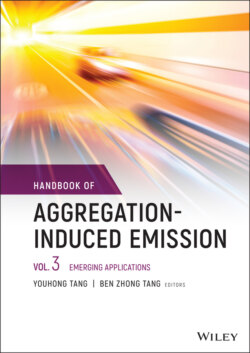Читать книгу Handbook of Aggregation-Induced Emission, Volume 3 - Группа авторов - Страница 19
1.2.4 Aggregation‐induced Emission‐active Emitters‐Based White OLED
ОглавлениеWhite organic light‐emitting devices (WOLEDs) have attracted significant research interest both in academia and industry due to their potential application in solid‐state lighting and full‐color displays. Till now WOLEDs were usually obtained by blending the emission from two‐colored (blue and yellow) or three‐colored (red, green, and blue) emitters. One possible solution to preparing WOLEDs is to dope the emitters into a wide band‐gap host to overcome the ACQ effect. Tang et al. reported a novel blue‐emissive AIE material BTPE (Figure 1.5) with wide band gap of 3.1 eV. Based on this material as the host and the commercially available emitters DCJTB doped as the EML, the related WOLEDs could reach color rendering index, maximum luminance, and CE of 84, 10 319 cd/m2, and 7 cd/A, respectively, with CIE coordinate of (0.36, 0.38) [79].
Figure 1.5 Molecular structures of conventional AIE‐active emitters to construct WOLEDs.
Although the doping approach can effectively overcome the ACQ problems, it usually requires precise control over the dopants concentration, and the resulting emission also suffers from the drawbacks of insufficient energy transfer. From this point, nondoped methodology can solve such problem, but it usually posed a challenge for the fabrication, because the EMLs with normal emitters for WOLEDs should be ultrathin, about 1 Å, in order to avoid the ACQ disadvantages [80]. In this prospective, the AIE luminogens can overcome these drawbacks of ultrathin fabrication, because they exhibited high PLQYs in aggregated state, therefore showing high potentials especially in nondoped WOLEDs. Tang et al. took advantage of bluish‐green AIE emitter of TTPEPy (Figure 1.5) and red AIE emitter of BTPETTD to prepare nondoped fluorescent WOLEDs, which exhibited the maximum luminance, CE, and PE, of 18 000 cd/m2, 7.4 cd/A, and 4 lm/W, respectively, with a reduced efficiency roll‐off, a high color rendering index of 90, and high color stability over a wide range of driving voltages [81]. To further simplify the process and reduce the cost of OLED, nondoped bilayer WOLED was fabricated by two emitters BTPETTD and DPPi with complementary colors of red and blue, respectively, while BTPETTD (Figure 1.5) and DPPi also served as the HTL and ETL, respectively. Through such a configuration, most of the excitons recombined in the DPPi layer gave off blue emission, while excitons captured by BTPETTD emitted red EL. And the bilayer WOLED based on the combination of these two emissions provided an efficient and stable white‐color emission, with CIE coordinates of (0.31, 0.31), CE of 4.2 cd/A at 1000 cd/m2 [82]. Similarly, Ma et al. used prepared nondoped WOLEDs by adopting two aggregation‐induced enhanced emission (AIEE) materials, TDPVBi and CN‐DPASDB (Figure 1.5) with blue and orange emission, respectively. And the related WOLED exhibited a maximum CE, PE, and luminance of 7.9 cd/A, 6.2 lm/W, and 25 350 cd/m2, respectively [83].
In other research, blue AIE emitters were also mixed with phosphorescent emitters to prepare WOLEDs. Chen reported an AIEgen CzPATPE (Figure 1.5) with sky‐blue emission around 495 nm and high triplet gap energy ET between 2.05 and 2.16 eV, making it possible to serve as the host material for the orange dopant of Ir(2‐phq) 3 (ET ∼ 2.13 eV). Through solution process, AIE hybrid white OLED were prepared with structure of ITO/PEDOT : PSS (65 nm)/CzPATPE : Ir(2‐phq) 3 (99.9 : 0.1, ∼40 nm)/TmPyPB (50 nm)/CsF (2 nm)/Al (100 nm), exhibiting white emission with CIEx,y of (0.36, 0.43) and the modest maximum EL and PE of 3.4 cd/A and 1.8 lm/W, respectively [84]. Tang et al. took advantage of blue AIEgen BTPEAn (Figure 1.5) and an orange phosphorescent emitter Ir(dmppy) 2(dpp) to prepare nondoped WOLEDs, with high CRI and PE of 85 and 35.0 lm/W, respectively. Besides, based on the same blue AIEgen and other two phosphorescent emitters Ir(dmppy) 2(dpp) and Ir(piq) 3 of red and orange emission, respectively, they also prepared three‐color nondoped WOLED exhibits with CRI > 90 at ≥ 3000 cd/m2 [85]. In their further work, they utilized another blue AIEgen TPE‐TAPBI (Figure 1.5) as the nondoped blue‐emitting component to fabricate two‐color hybrid WOLEDs, with warm white light with CIEx,y of (0.45, 0.46) and PE, CE, and EQE of 70.5 lm/W, 76.0 cd/A, and 28%, respectively [86]. Recently, Tang and Ma reported several novel, blue AIEgen without typical AIE moieties such as TPE or silole to prepare WOLEDs. They prepared 3TPA‐CN (Figure 1.5) as both blue emitter and phosphor host for the red phosphore Ir(tptpy) 2acac to fabricate nondoped hybrid WOLED, with maximum PE and EQE reaching 86.7 lm/W and 22.3%, respectively [87]. In another research, based on the same deep‐blue AIE material TPB‐AC (Figure 1.5) as both excellent blue emitter and host for phosphor emitters, two‐color and four‐color WOLEDs were prepared with high CRI (>90), EQEmax > 25%, and PEmax = 99.9 lm/W [88].
WOLEDs can also be obtained through the method of blue OLED with color down conversion layer (CCL), with the advantage of simple fabrication process and high color stability [89, 90]. Kowk et al. utilized orange‐red emissive emitter BTPETTD (Figure 1.5) as a CCL on top‐emitting blue OLEDs by thermal evaporation, with 74.5% of the blue emission converted to red emission at the efficiency of 40%. And resulting top‐emitting WOLEDs were realized by mixing the left blue and red emission, with CIE coordinate, CE, and PE of (0.34, 0.35), 17.7 cd/A, and 8.7 lm/W, respectively [91].
